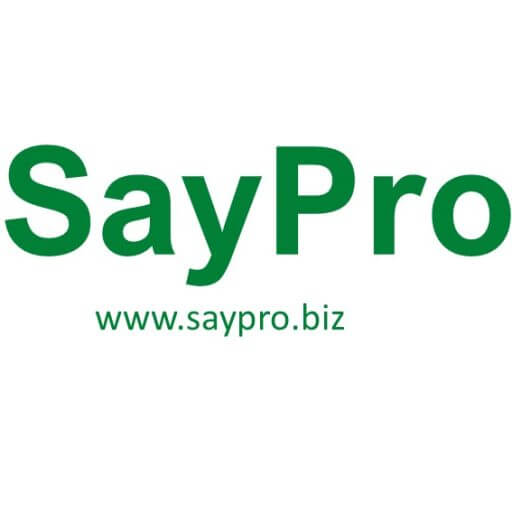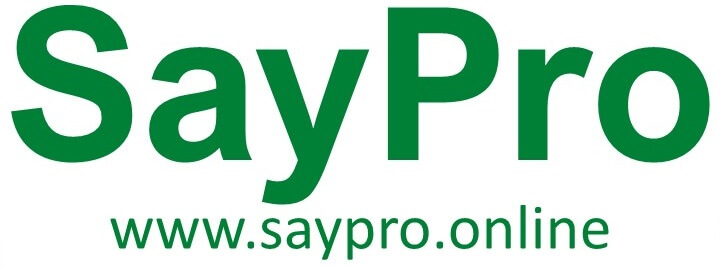Your basket is currently empty!

SayPro: Marketing Email Marketing Training Course
R5 999,00
Description
SayPro: Marketing Email Marketing Training Course
Module 1: Introduction to Email Marketing
Importance of Email Marketing in Modern Business
Key Benefits of Email Marketing
Module 2: Setting Up Your Email Marketing Strategy
Defining Your Email Marketing Goals
Identifying Your Target Audience
Choosing the Right Email Marketing Platform
Module 3: Building and Growing Your Email List
Best Practices for List Building
Creating Effective Opt-In Forms
Managing and Segmenting Your Email List
Module 4: Crafting Effective Promotional Emails
Writing Compelling Subject Lines
Designing Beautiful and Responsive Emails
Creating Engaging Content for Your Emails
Module 5: Sending Newsletters and Promotional Emails
Types of Emails: Newsletters vs Promotional Emails
Timing and Frequency of Email Campaigns
Testing and Optimizing Email Deliverability
Module 6: Automating Your Email Campaigns
Introduction to Email Automation
Setting Up Automated Email Sequences
Advanced Automation Techniques
Module 7: Analyzing and Optimizing Email Performance
Using A/B Testing to Improve Performance
Module 8: Email Marketing Compliance and Best Practices
Understanding Email Marketing Laws (GDPR, CAN-SPAM)
Ensuring Deliverability and Avoiding Spam Filters
Ethical Email Marketing Practices
Module 9: Advanced Email Marketing Techniques
Personalization and Dynamic Content
Using Behavioral Data for Targeted Emails
Module 1: Introduction to Email Marketing
What is Email Marketing?
Email marketing involves sending emails to a group of people with the goal of promoting products, services, or building relationships with the audience. It’s one of the most cost-effective ways to reach and engage customers directly.
Importance of Email Marketing in Modern Business
In today’s digital world, email marketing remains a powerful tool because it allows for personalized communication with your audience. Key reasons email marketing is important:
- High ROI: Email marketing offers one of the highest returns on investment compared to other marketing channels.
- Direct Communication: Allows businesses to communicate directly with their audience.
- Scalability: Emails can be sent to thousands of users with a single click.
Key Benefits of Email Marketing
- Customer Retention: Keep your brand top of mind with regular email communication.
- Cost-Effective: Low cost to send emails compared to traditional forms of advertising.
- Measurable: Easily track open rates, click-through rates, and other key metrics.
Task:
Write a brief explanation of what email marketing is and list two benefits it can bring to your business.
Assignment:
Find an email marketing campaign that you like. Analyze the subject line, design, and content. Write a brief report on why you think it works.
Quiz:
- What is the primary goal of email marketing?
- Name two benefits of email marketing.
Module 2: Setting Up Your Email Marketing Strategy
Defining Your Email Marketing Goals
Before starting any campaign, you need to define your objectives. Are you trying to increase sales, drive traffic to your website, or build brand awareness? Common email marketing goals:
- Increase engagement with existing customers
- Boost sales through targeted offers
- Build trust and brand loyalty
Identifying Your Target Audience
Understanding your audience is crucial to creating effective email campaigns. Start by segmenting your email list based on factors like:
- Demographics (age, location)
- Past purchase behavior
- Email engagement history
Choosing the Right Email Marketing Platform
There are many platforms available for creating and sending email campaigns. When choosing the right platform, consider:
- Ease of use
- Available templates and customization options
- Integrations with other tools (CRM, analytics)
- Price and scalability
Popular email platforms include Mailchimp, Constant Contact, and Sendinblue.
Task:
Identify your email marketing goal for the next campaign and write a short description of your target audience.
Assignment:
Create an outline for your email marketing strategy. Include your goal, target audience, and which email platform you plan to use.
Quiz:
- What are two common email marketing goals?
- Why is it important to define your target audience?
Module 3: Building and Growing Your Email List
Best Practices for List Building
Building an email list starts with providing value. Here are some strategies for growing your list:
- Offer Incentives: Discounts, free resources, or exclusive content can entice people to subscribe.
- Use Sign-Up Forms: Embed sign-up forms on your website, blog, or landing pages.
- Leverage social media: Promote your email sign-up form on social platforms.
Creating Effective Opt-In Forms
Opt-in forms should be easy to fill out and visually appealing. Focus on:
- A clear call to action (CTA)
- A compelling incentive
- Minimal required fields (email address, name)
Managing and Segmenting Your Email List
Once you have a list, segment it based on:
- Demographic data (age, gender, location)
- Purchase history or engagement level
- Behavioral data (clicked links, opened emails)
Task:
Create a simple opt-in form for a hypothetical business. Decide what kind of incentive you’ll offer to encourage sign-ups.
Assignment:
Research and create a strategy for growing your email list using one of the methods discussed above.
Quiz:
- Name one effective strategy for growing an email list.
- What is the benefit of segmenting your email list?
Module 4: Crafting Effective Promotional Emails
Writing Compelling Subject Lines
The subject line is the first thing recipients see. Make it:
- Short and sweet
- Intriguing and attention-grabbing
- Relevant to the email content
Designing Beautiful and Responsive Emails
Design emails that look good on all devices, especially mobile. Key design principles:
- Clear and easy-to-read fonts
- Use images sparingly to enhance content
- Optimize email for mobile viewing
Creating Engaging Content for Your Emails
Content is king. Your email should:
- Be valuable to your audience
- Include a clear call to action (CTA)
- Provide a solution to your audience’s problem
Task:
Create a subject line for a promotional email campaign. Write a short email (150 words) with a compelling offer.
Assignment:
Design an email template using your chosen email platform. Focus on clean design and mobile optimization.
Quiz:
- What should you keep in mind when writing a subject line?
- Why is responsive design important for email marketing?
Module 5: Sending Newsletters and Promotional Emails
Types of Emails: Newsletters vs Promotional Emails
- Newsletters: Regular, informational emails sent to a list with company updates, tips, and content.
- Promotional Emails: Focus on driving sales, offering discounts, or encouraging specific actions.
Timing and Frequency of Email Campaigns
The timing of your emails matters. Key factors to consider:
- Best days to send (Tuesdays and Thursdays tend to perform well)
- Frequency of emails (don’t overwhelm your subscribers)
- Optimal sending time (morning or mid-day)
Testing and Optimizing Email Deliverability
Your email could end up in the spam folder if not done right. Ensure:
- You’re using a reputable email platform
- You’re following email best practices
- You test subject lines, content, and delivery times
Task:
Create a content calendar for sending weekly newsletters and promotional emails.
Assignment:
Set up your first email campaign and send a test email to yourself for review.
Quiz:
- What’s the difference between a newsletter and a promotional email?
- What’s one way to avoid your emails being marked as spam?
Module 6: Automating Your Email Campaigns
Introduction to Email Automation
Email automation allows you to send pre-scheduled emails based on triggers, such as:
- Welcome emails
- Abandoned cart reminders
- Post-purchase follow-ups
Setting Up Automated Email Sequences
Create email sequences for different purposes:
- Welcome Series: Introduce new subscribers to your brand.
- Engagement Sequences: Keep users engaged with regular content.
- Re-engagement Sequences: Reconnect with inactive subscribers.
Advanced Automation Techniques
- Dynamic content based on user behavior
- Triggering emails based on actions taken on your website
Task:
Design a 3-email welcome sequence for new subscribers.
Assignment:
Set up an automated email sequence using your chosen email marketing platform.
Quiz:
- What is email automation?
- Name one example of an automated email sequence
Module 7: Analyzing and Optimizing Email Performance
Key Metrics to Track
To measure the success of your email marketing campaigns, it’s crucial to track the following metrics:
- Open Rate: The percentage of recipients who opened your email.
- Click-Through Rate (CTR): The percentage of recipients who clicked a link in your email.
- Conversion Rate: The percentage of recipients who completed the desired action (such as making a purchase).
- Bounce Rate: The percentage of emails that couldn’t be delivered to recipients.
- Unsubscribe Rate: The percentage of recipients who opt out of receiving your emails.
Using A/B Testing to Improve Performance
A/B testing involves comparing two versions of an email to see which performs better. Common elements to test include:
- Subject lines
- Call-to-action buttons
- Images vs. no images
By testing different variables, you can optimize your emails for higher engagement.
Making Data-Driven Decisions
Use the insights gained from metrics and A/B tests to make informed decisions. For example:
- If your open rate is low, try adjusting your subject line.
- If your click-through rate is low, consider changing the placement or wording of your CTA.
- If your conversion rate is low, examine your email’s content and landing page to ensure they align.
Task:
Track the performance of a recent email campaign. List the key metrics (open rate, click-through rate, etc.) and analyze what worked well and what needs improvement.
Assignment:
Perform an A/B test on one of your email campaigns, focusing on subject lines or CTAs. Document the results and any improvements made.
Quiz:
- What are two key metrics you should track for email campaigns?
- What is the purpose of A/B testing in email marketing?
Module 8: Email Marketing Compliance and Best Practices
Understanding Email Marketing Laws (GDPR, CAN-SPAM)
Email marketing is regulated by laws that protect consumer privacy. Two major regulations include:
- GDPR (General Data Protection Regulation): A European Union regulation that ensures the privacy and protection of personal data.
- CAN-SPAM Act: A U.S. law that sets rules for commercial email, such as the requirement to include an opt-out option.
Ensuring Deliverability and Avoiding Spam Filters
To ensure that your emails land in the inbox and not the spam folder:
- Avoid using spammy language (e.g., “free”, “guaranteed”, “limited time offer”).
- Use a reputable email service provider (ESP).
- Ensure you have permission to send emails (opt-in).
- Include a clear unsubscribe link in every email.
Ethical Email Marketing Practices
Respect your subscribers and ensure you’re sending relevant content. Best practices include:
- Always using double opt-in for list building.
- Personalizing emails to make them more relevant.
- Respecting privacy by not selling or sharing email addresses.
Task:
Research and summarize the key points of GDPR and CAN-SPAM, explaining how they impact email marketers.
Assignment:
Review one of your past email campaigns to ensure it complies with these regulations. Make any necessary changes to comply with email marketing laws.
Quiz:
- What does GDPR stand for, and how does it affect email marketing?
- What should you include in every email to comply with the CAN-SPAM Act?
Module 9: Advanced Email Marketing Techniques
Personalization and Dynamic Content
Personalization allows you to tailor emails to individual recipients based on their preferences, behaviors, and data. Examples include:
- Addressing recipients by name
- Sending product recommendations based on previous purchases
- Customizing email content based on location or interests
Dynamic content enables you to send emails that automatically change based on user data. For example, you could show different content in an email depending on whether the recipient is a first-time buyer or a returning customer.
Segmentation Strategies
Segmenting your email list allows you to send targeted emails to different groups. Common segmentation strategies include:
- Demographics: Age, gender, location
- Behavior: Past purchases, email engagement
- Lifecycle: New subscribers, active customers, inactive users
Using Behavioral Data for Targeted Emails
Behavioral data provides insights into how your subscribers interact with your emails and website. Use this data to send timely and relevant emails. For example:
- Abandoned cart emails: Send a reminder to customers who left items in their cart.
- Re-engagement emails: Send targeted campaigns to subscribers who haven’t opened or clicked emails in a while.
Task:
Set up a segmentation strategy for your email list, based on demographic and behavioral data. Decide which types of emails you will send to each segment.
Assignment:
Create a personalized email campaign for a specific segment (e.g., first-time buyers). Use dynamic content where possible.
Quiz:
- How can dynamic content improve the effectiveness of your email marketing?
- What are two types of data you can use for email segmentation?
You must be logged in to post a review.
Vendor Information
- No ratings found yet!
-

SayPro :Marketing Security Training Course
R5 999,00 Add to basket -

SayPro: Marketing Social Sharing Training Course
R4 999,00 Add to basket -

SayPro :Marketing Disaster Recovery Training Course
R5 999,00 Add to basket -

SayPro: Marketing Banner Ads Training Course
R4 999,00 Add to basket -

SayPro :Marketing Social Media Links Training Course
R4 999,00 Add to basket -

SayPro: Marketing Data Backup Training Course
R3 999,00 Add to basket















Reviews
There are no reviews yet.